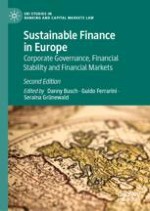2024 | OriginalPaper | Buchkapitel
12. Sustainable Finance: An Overview of ESG in the Financial Markets
verfasst von : Marieke Driessen
Erschienen in: Sustainable Finance in Europe
Aktivieren Sie unsere intelligente Suche, um passende Fachinhalte oder Patente zu finden.
Wählen Sie Textabschnitte aus um mit Künstlicher Intelligenz passenden Patente zu finden. powered by
Markieren Sie Textabschnitte, um KI-gestützt weitere passende Inhalte zu finden. powered by
